|
FINLAND- Finland designed a class of boats based on German Navy's U-Boat (UB-III) at the end of World War I. Ironically, the Finnish Class was used by the German as the basis for two World War 2 Kriegsmarine U-Boat, the Type II (coastal) and Type VII (medium). During World War 2, the Finland Submarine Fleet consisted of three boats from the Festinate Class, Vetehinen, Vesihiisi, and Tku-Turso plus two smaller types, Vesikko and Saukko. During the Winter War of 1939-1940, sub operations were limited due to heavy ice conditions, but mines were still laid close to the Soviet occupied Estonia. Due to bad torpedoes from Italy, the targets sunk by Finland submarines were very limited. In 1942, the boats were moved to Aland to secure open sea lanes to Sweden. During this period at least three Soviet submarines were sank. In 1944 the eastern part of the Gulf of Finland was the main patrol areas but only mining operations were conducted. The 1947 Treaty of Paris struck a blow to the Finnish submarine fleet. It banned Finland's use of submarines. Upon this order, all submarines with the exception of Vesikko were scrapped. The Vesikko is used as a musuem by the Submarine Veterans. Finland has no submarine badge for wear on their uniforms during World War 2. The members of the Finnish Submarine Veterans Association does currently have a badge. It is in a goldish copper with a submarine showing its port side on top of three sets of waves. The abbreviation SuvLv on the badge stands for Sukellusvenelaivue. |
|
FRANCE- In 1863, the French Navy launched its first submarine, Plounguer. It had a compressed air engine and was not taken seriously as a weapon. Two all-electric types were the prototypes for the development of hydroplanes, conning towers, and periscope technology. The biggest downfall was the requirement for the boat to reurn to port to recharge its batteries. In 1899, the Narval, a steam and electric powered submarine, followed and the Naiade followed in 1904 which employed gasoline and electricity. The first practical submarine was built in 1904 and it employed a diesel-electric propulsion. During World War I, France's submarine force consisted of 79 active submarines, but only 39 were in service. Due to poor torpedo technology and the absence of war targets, the effectiveness of the submarine force was minimal. At the end of the war, France received 10 German subs as a reparation from the conflict. These subs served as models for at least seven French built submarines. A famous submarine which came out of this period was the Surcouf, which contained two 8-inch guns and a reconnaissance plane. During World War 2, Free-French had a force which numbered twenty boats thanks to captured subs in various British ports, captured Italian subs, and some loaned subs from Britain. The new Narval Class was based on more war reparations from Germany. This was a huge success for the French and they ended up building six of them. After these, four Arethuse, nine Daphne, and four Agosta Class boats were constructed. The Ledoutable Class (SSBNs) and L'Inflexible Class (SSBN) followed those along with the Rubis and Amethyse Class (SSNs). The current active list consist of 5 L'Inflexible Class, 6 Rubis Class, 4 Agosta Class and 3 Daphne Class. The top badge is the early Basic Submariner Badge. Offical sources cite conflicting information of the period it was issued. One states 1946 while another states 1961. This badge is worn by all ranks. The badge has a gold submarine on a silver compass rose. The sail has a step notch in it. The next is the modern version of the early Basic Submariner Badge. The only difference is that the gold submarine is mounted on a larger compass rose. This badge is worn by officers and warrant. It is worn onthe right breast. The one sword badge is the Advanced Submariner Badge. This badge is the modern version of the original badge but the step notch has been removed. This is an officer badge and is worn on the right breast. The two sword badge was issued in 1974. This is the Command Qualified Officer's Badge. It worn by officers that have completed the qualification of sub commander. It is worn on the right breast. |
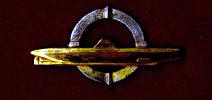
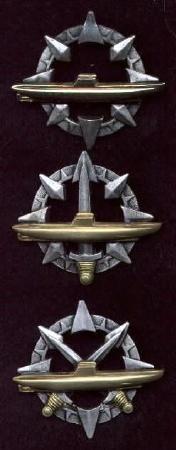
|
GERMANY- Germany was the front runner in submarine warfare in World War II. The first submarine built by German was in 1850, but it was a failure when it sank during sea trials. Their first successful submarine was designated U-1. Germany foresaw the great potential that was found in submarines as a means of strategic warfare. During World War I, Germany made history with their feats by the U-Boats. The U-Boat is probably the most written about in submarine history. At the end of the war, Germany had 179 U-Boats in service with another 150 being built. This was divided up among the Allies for reparations. This did not stop German in submarine warfare. German set an office in the Netherlands to work on designs for Spain and Finland. This help Germany during her rearmament in 1935. At the beginning of World War II, Germany had 57 U-Boats active. At the end of the war 1190 submarines had been built. Though the success of this fleet wa high, Germany loss over 70 percent of the crews. The Brundesmarine was created in the early 1950s with the refurbishing of the U-2365. It was renamed as the Hai. Another sank U-boat was raised and renamed as the Hecht. Since then numerous classes of submarine have been created for Germany and many other foreign navies. At this time, the Brundsmarine has twenty submarines, six Type 206, 12 Type 206a, and two Type 205. Four Type 212 are being built and three more are projected for the future. The U-Boat War Badge, Imperial Navy was instituted in 1918. This badge was given to German and Austro-Hungarian submariners. The badge has a tall-masted submarine rounded by a oval wrapped wreath with a Hohenzollen crown. It is worn on or below the left pocket. The U-Boat War Badge was instituted in 1939 and is very similiar to the earlier badge except that the submarine was modernized, the wreath is not wrapped, and the crown was replaced with the Nazi eagle. This badge was not a qualification badge. It was awarded for certain actions during combat situations. The U-Boat War Badge with diamonds was only awarded 28 times to people who had earned the Knight's Cross of the Iron Cross with Oak leaves. This was not awarded by the government but by the Commander of the Navy. It contain 12 diamonds in the wreat and 13 in the swastika. In 1944, the U-Boat Clasp was introduced to honor those that had completed specified amounts of times of continous active service in submarines. The first badge was bronze. A few months later in that year, a silver clasp was introduced for even greater service. These badges were worn above the left pocket or medal bar. A gold version can be found but it was never issued. The Combat Badges of Small Battle Units had a barracuda on top of an interwined rope. The bronze version was for five or more missions, silver was for seven or more missions, and gold was for ten or more missions. This badge was never issued during the war, but it was awarded after the denazification of Germany after the war. The Achievement Badge for Shipyard Workers was introduced in 1944 for the efforts of the shipyard workers. The badge was a stickpin with a U-Boat sailing through a gear wheel. In 1957, all badge were denazified including the U-Boat Combat Clasp. The current and official badge was issued in 1984. The badge has a Type 206 Class submarine on a double wreath with background pebbled. It is worn by all ranks. The badge is a clutch pin attachment. The U-Boat Veteran's Pin is a denazified U-Boat badge with an enamel Iron Cross appliqued above the submarine on the wreath. This is the official badge of the U-Boat Veterans' Association. |
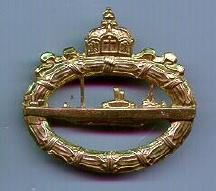
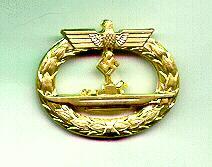
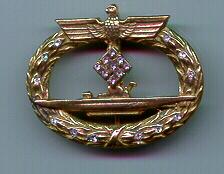
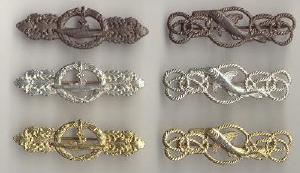
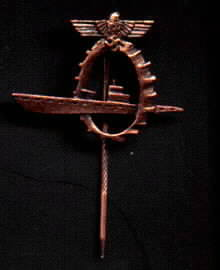
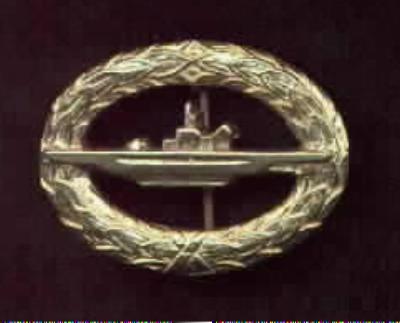
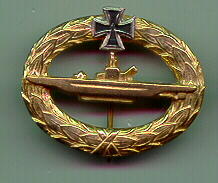
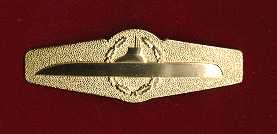
|
GREECE- The Greek Navy holds the claim to fame of having the first submarine, Delphin, to fire a torpedo in combat during the First Balkan War. Commanded by Lieutenant Commander Paparrigouplis, the Delphin fired her torpedos at a Turkish cruiser on 9 December 1912. The Delphin failed to sink the ship, but it was the key to modern submarine combat. The Greek submarine force consists of the Glavkos Class which is a German 209 (Type 1100 and 1200) submarines totaling eight assets. The top badge is the current officer and petty officer's version of the Greek Submarine Badge in gold metal. It is worn on the left breast. It is attached with screw post and nut. The next set shows the miniature of the Officer/ Petty Officer submarine badge. It is attached with clutchpins. The silver badge is a minature os the Seaman's version of the submariner's badge. The badge is obselete. |

| Home Page |